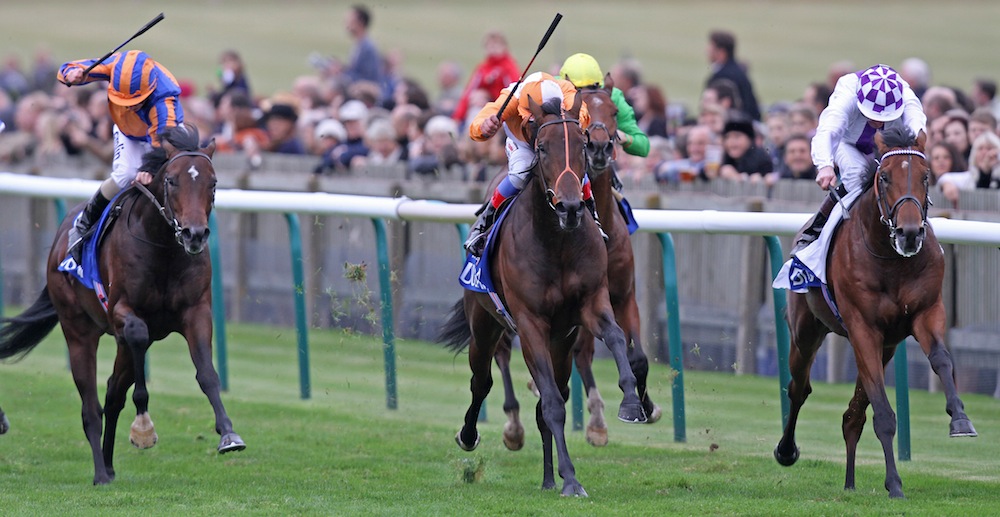Thoroughbred Racehorses Get Speed from Just a Few Ancestors

Thoroughbred horses owe their amazing sprinting capabilities to just a couple of ancestors, according to a new study that traces the genetics of these racehorses.
The research finds that a genetic variant associated with speed likely originated with a single mare in the mid-17th century. The gene variant became widespread in modern thoroughbreds, thanks to a single stallion named Nearctic, the father of the most-bred stallion of modern times.
"Changes in racing since the foundation of the Thoroughbred have shaped the distribution of 'speed gene' types over time and in different racing regions," study researcher Emmeline Hill, a genomics scientist at University College Dublin, said in a statement.
Built for speed
In 2010, Hill and her colleagues announced they had discovered how variations in the genetic code of thoroughbreds translated to speed. A gene called MSTN, associated with muscle growth, comes in two varieties, or alleles: C and T. Horses with two copies of the C allele are fast, short-distance sprinters. Horses with one C and one T tend to be strong middle-distance runners. And T/T horses have less speed, but greater stamina. [Top 10 Animal Recruits in War]
Now, Hill and her colleagues have traced the history of the C and T alleles, reaching back into the horse family tree to learn where these genetic variations arose and how they spread as the demands of horse breeders changed. The C variant doesn't show up in distant horse cousins such as zebras, the researchers found, revealing that the stamina-bestowing T was the norm in ancestral wild horses. That makes sense, Hill and her colleagues report today (Jan. 24) in the journal Nature Communications, as wild horses needed the ability to roam over long distances.
The C allele shows up in other breeds of domesticated horses besides thoroughbreds, the researchers found. European and Asian horses have it, as do almost all American quarter horses, another talented sprinter and the most popular horse breed in the U.S. today.
Sign up for the Live Science daily newsletter now
Get the world’s most fascinating discoveries delivered straight to your inbox.
Registered thoroughbreds haven't reproduced outside their breed since 1791, so the researchers knew that the C allele had to have been in the line by that time. Fortunately for their research, thoroughbred breeding records are, well, thorough, and all modern thoroughbreds can trace their paternal lineages back to one of three stallions: Byerly Turk, which lived in the 1680s; Darley Arabian, born in 1704; and Goldolphin Arabian, born in 1729.
By testing historical samples related to Darley Arabian, the researchers were able to determine that he lacked the C allele. It's not clear whether the other two stallions had this allele, but their contribution to the gene pool is minimal compared with Darley. That makes it most likely that the C variant entered the thoroughbred line through a single mare bred in the 17th century, right before the thoroughbred population closed off to outbreeding.
"The results show that the 'speed gene' entered the Thoroughbred from a single founder, which was most like a British mare about 300 years ago when local British horse types were the preeminent racing horses," Hill said.
Dominating genes
But that finding didn't explain how the C allele became so widespread in modern thoroughbreds. To find out, the researchers examined the pedigrees of 56 elite-performing C/C and T/T horses. They found that the genetic data converged on one horse, Nearctic, born in 1954 to a stallion named Nearco, who was known as one of the best racehorses of the era. Nearctic, in turn, sired a horse named Northern Dancer, in 1961.
Northern Dancer never came in lower than third in his time as a racehorse, and he won 14 of the 18 races he ran. When he retired, he became the most influential stud horse of the era, according to the National Thoroughbred Racing Association. At one point in the 1980s, it cost $1 million to have Northern Dancer breed with a mare.
Northern Dancer's prolific breeding allowed the C allele to spread far and wide among thoroughbreds, the researchers found. But it wasn't just good looks and luck that made Northern Dancer popular. In the late 1800s and into the 1900s, horses began at racing younger and younger ages, starting at 2 rather than 5 or 6. At the same time, races were becoming shorter. The C allele, which leads to fast muscle growth early in life, made for good sprinters for this new type of racing.
This little gene means big bucks for horse breeders and owners. The winnings of all of Northern Dancer's 635 registered foals, for example, exceeded $26 million at the time of their sire's death in 1990. Hill is a co-founder of Equinome, a company which tests for the C and T alleles. This test is used by the racing industry to determine the optimal racing distances for individual Thoroughbreds.
The study also reveals the power of racing trends in determining the genetics of racehorses, Hill said.
"This just goes to show the power breeders have to shape the genetic make-up of their horses," she said. "Decisions regarding the race pattern in each racing jurisdiction and the commercial demand for certain types will also rapidly influence the genetic make-up of the population."
You can follow LiveScience senior writer Stephanie Pappas on Twitter @sipappas. Follow LiveScience for the latest in science news and discoveries on Twitter @livescience and on Facebook.

Stephanie Pappas is a contributing writer for Live Science, covering topics ranging from geoscience to archaeology to the human brain and behavior. She was previously a senior writer for Live Science but is now a freelancer based in Denver, Colorado, and regularly contributes to Scientific American and The Monitor, the monthly magazine of the American Psychological Association. Stephanie received a bachelor's degree in psychology from the University of South Carolina and a graduate certificate in science communication from the University of California, Santa Cruz.
